FIRST® Games
2018 - POWER UP
FIRST POWERUP is played by two alliances of three robots each. Each match is 2 minutes and 30 seconds long. Robots operate using pre-programmed instructions for the first 15 seconds of each match and then drivers control the robots for the remainder of the match.
During AUTO, alliances score points by reaching their own autonomous line and gaining ownership of the scale or their switch. Each three-robot allaince has three ways to help defeat the boss during TELEOP: owning the scale or their switch, playing power-ups, and climbing the scale on a rung. Ownership occurs when the scale or alliance's switch is tipped in their favor. Robots collect and deliverpower cubes to gain ownership. Alliances can exchange power cubes for power-ups. Power-ups provide a timed advantage during the match. There are three power-ups that can be played: FORCE, BOOST, and LEVITATE.
2017 - Steamworks
FIRST STEAMWORKS is played by two alliances of three robots each on a 27 ft. by 54 ft. 4 in. field. Each match is 2 minutes and 30 seconds long. Robots operate using pre-programmed instructions for the first 15 seconds of each match and then drivers control the robots for the remainder of the match.
The objective of FIRST STEAMWORKS is for robots to work together to gain points by scoring green balls, or "fuel," into the low or high goals of a boiler, or by retrieving and delivering gears to the "airship" in the middle of the field. The human players on the airship will collect and install the gears. If enough, the gears are installed and will be used to turn the rotors and award the alliance extra points. During t he last 30 seconds of the match, ropes are deployed from the airships, and robots can climb up the ropes to score even more points. The alliance with the highest socre wins the match!
2016 - Stronghold
FIRST STRONGHOLD is a medieval tower defender game in hich two alliances of three teams each select defenses to fortify their outer works before competing simultaneously to score points while breaching the opponent's outer works and capturing the opponent towers.
Each match is two minutes and thirty seconds long. The Autonomous Period (AUTO) is the first fifteen seconds of the match in which robots operate without any drive control or input. The Teleoperated Period (TELEOP) is the remaining two minutes and fifteen seconds of a match in which robots may be directly controlled by driver and/or human players.
During AUTO, points are earned by robots that reach or cross a defense and scorew boulders in goals. During TELEOP, points are earned by robots crossing undamaged defense, socring boulders in goals, and challenging or scaling the opponent's tower.
2015 - Recycle RushSM
RECYCLE RUSHSM is a recycling-themed game played by two Alliances of three robots each. Robots score points by stacking totes on scoring platforms, capping those stacks with recycling containers, and properly disposing of pool noodles, representing litter. In keeping with the recycling theme of the game, all game pieces used are reusable or recyclable by teams in their home locations or by FIRST® at the end of the season.
Each Alliance competes on their respective 26 ft. by 27 ft. side of the playing field. Each match begins with a 15-second Autonomous Period in which robots operate independently of their drivers. During this period, robots attempt to earn points by moving themselves, their yellow totes, and their recycling containers into the area between the scoring platforms, called the Auto Zone.
During the remaining two minutes and 15 seconds of the match, called the Teleop Period, robots are controlled remotely by student drivers located behind the walls at the ends of the field. Teams on an Alliance work together to place as many totes on their white scoring platforms as possible. Alliances earn additional points for recycling containers placed on the scored totes, with containers at greater height earning more points.
Alliances also earn points for disposing of their litter in their Landfill Zone near the center of the field, or placing litter in or on scored recycling containers. Alliances that leave litter unprocessed on their side of the field at the end of the match, not in scoring position, will add points to the score of the other Alliance.
Alliances have an opportunity to earn Coopertition® points by coordinating with the other Alliance in the match. Coopertition points are awarded if, at some point in the match, there are at least four yellow totes on the step simultaneously. Coopertition points are doubled if the Alliances arrange at least four of those yellow totes in a single stack on the step.
2014 - Aerial AssistSM
AERIAL ASSISTSM is played by two competing Alliances of three robots each on a flat 25’ x 54’ foot field, straddled by a truss suspended just over five feet above the floor. The objective is to score as many balls in goals as possible during a two (2)-minute and 30-second match. The more Alliances score their ball in their goals, and the more they work together to do it, the more points their Alliance receives.
The match begins with one 10-second Autonomous Period in which robots operate independently of driver. Each robot may begin with a ball and attempt to score it in a goal. Alliances earn bonus points for scoring balls in this mode and for any of their robots that move in to their zones. Additionally, each high/low pair of goals will be designated “hot” for five seconds, but the order of which side is first is randomized. For each ball scored in a “hot” goal, the Alliance earns additional bonus points.
For the rest of the match, drivers remotely control robots from behind a protective wall. Once all balls in autonomous are scored, only one ball is re-entered in to play, and the Alliances must cycle a single ball as many times as possible for the remainder of the match. With the single ball, they try to maximize their points earned by throwing balls over the truss, catching balls launched over the truss, and scoring in the high and low goals on the far side of the field.
Alliances receive large bonuses for “assists,” which are earned for each robot that has possession of the ball in a zone as the ball moves down the field. Points are awarded for each action per the table below.
2013 - Ultimate AscentSM
ULTIMATE ASCENTSM is played by two competing alliances on a flat, 27 x 54 foot field. Each Alliance consists of three robots, and they compete to score as many discs into their goals as they can during a two (2)-minute and fifteen (15)-second match. The higher the goal in which the disc is scored, the more points the Alliance receives.
The match begins with a fifteen (15)-second Autonomous Period in which robots operate independently of driver inputs. Discs scored during this period are worth additional points. For the remainder of the match, drivers control robots and try to maximize their alliance score by scoring as many goals as possible.
The match ends with robots attempting to climb up pyramids located near the middle of the field. Each robot earns points based on how high it climbs. Scoring for the match is summarized below.
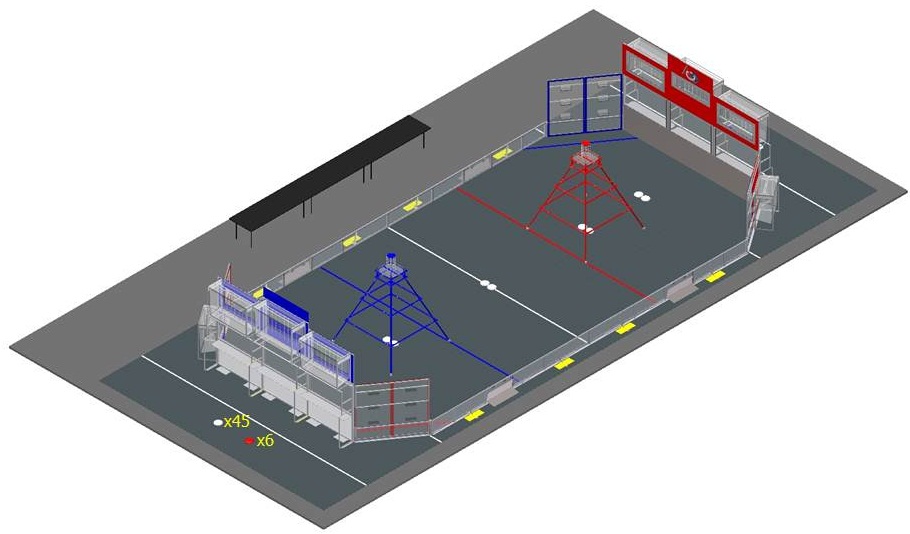
The Field for Ultimate Ascent
2012 - Rebound RumbleSM
Rebound RumbleSM is played by two competing alliances, each consisting of three robots. They compete to score as many basketballs into their hoops as they can during a 2 minute and 15 second match. The hoops are at three different llevels. The highest level basket gains a score of 3 points; the middle level baskets score 2 points; and the lower level basket is a score of 1 point.
The match begins with a 15-second Hybrid Period in which robots operate independently of driver inputs. During this Hybrid Period, one robot on each Alliance may be controlled using a Microsoft Kinect. Baskets scored during this period are worth extra points. For the remainder of the match, drivers control robots and try to score as many baskets as possible.
The match ends with robots attempting to balance on bridges located at the middle of the field. In Qualification Matches, a robot from each Alliance will also try to balance on the white CoopertititionTM bridge to score additional ranking points for each Alliance.
Above is the Field for Rebound Rumble, below are the Hoops
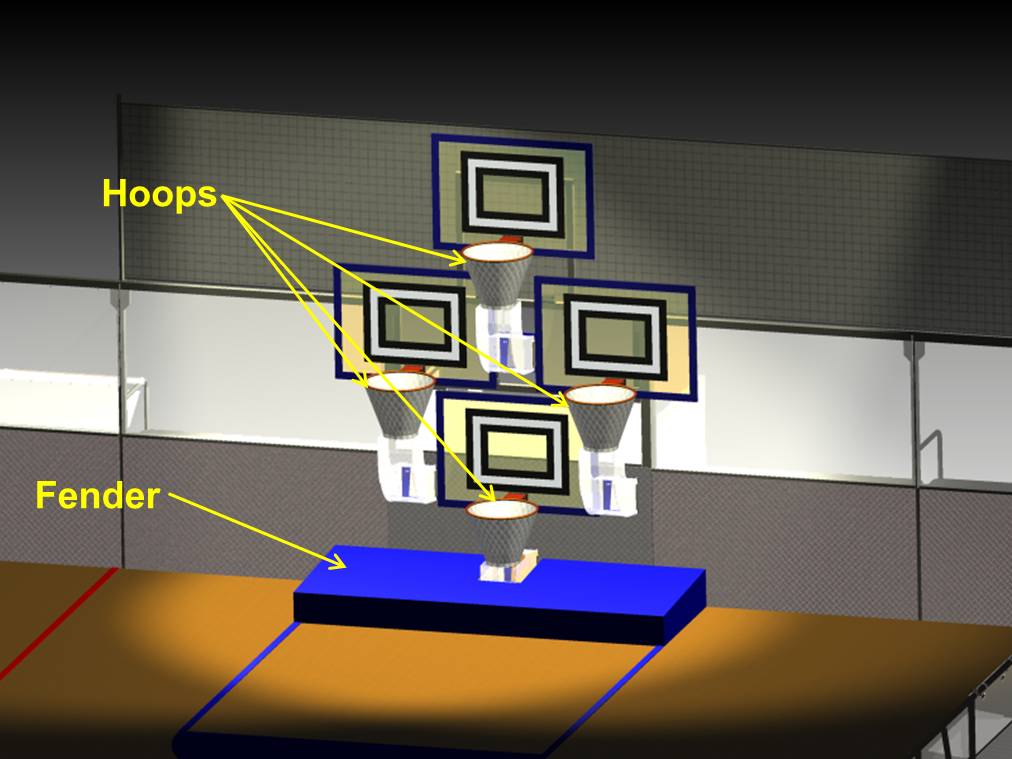
2011 - LOGO MOTION™
The Celebration of 20 Years of FIRST®
LOGO MOTIONTM is played by two competing alliances, each consisting of three robots. They compete to hang as many inflated plastic shapes (triangles, circles, and squares) on their grids as they can during a 2 minute and 15 second match. The higher the teams hang their game pieces on their scoring gird, the more points their alliance receives.
The match begins with one 15-second Autonomous Period in which robots operate independently of driver inputs and must hang Ubertubes to score extra points. For the rest of the match, drivers control robots and try to maximize their alliance score by hanging as many logo pieces as possible. Any logo piece hung on the same peg as an Ubertube receives double points. If teams assemble the logo pieces on their scoring grids to form the FIRST logo (triangle, circle, square, in a horizontal row in that order), the points for the entire row are doubled.
The match ends with robots deploying minibots, small electro-mechanical assemblies that are independent of the host robot, onto vertical poles. The minibots race to the top of the pole to trigger a sensor and earn additional bonus points.
.jpg)
Above is the Field for LOGO MOTION, below is the Scoring Grid
.jpg)
2010 - Breakaway™
This game is roughly based off of soccer. Two alliances (red and blue) made up of three robots each compete in each match. The field is divided into three sections by 13.5" tall bumps with 18" high tunnels that divide each bump. Each alliance score points by shooting balls into their goals.
The match starts with a 15-second Autonomous Period in which robots use pre-programmed code to score balls into the 4 goals. After the Autonomous Period finishes, the 2-minute teleoperated period begins. Human drivers take control of their robots and try to score balls, defend goals, and keep balls on their alliance's side of the field.
In the final 20 seconds of the match, alliances can score bonus points by lifting their robots above the platform of their alliance's tower (20") for 2 points. If a robot from the same alliance lifts itself from a currently elevated robot until it is above the platform of the tower, it is considered elevated, and gains that alliance 3 additional points.
Above is the Field for Breakaway, Below is the Ball Return
2009 - Lunacy™
The game is supposed to simulate driving on the Moon, celebrating the 40th anniversary of Man landing on the Moon. The floor is covered in a slick material called "Regolith" and all robots are required to use "Rover Wheels" to simulate the 1/6 gravity on the Moon.
Each robot has a "trailer" hitched to the back of it. Points are scored by robots shooting orbit balls into the opposing alliance robots' trailers. Each orbit ball is worth 2 points. A moorock is worth 2pts, an empty cell is worth 2pts, and a super cell is worth 15pts.
The match starts off with a 15-second Autonomous Period in which robots can track pink and green markers on top of another robot's trailer. Once the 2-minute Teleoperated Period begins, drivers can take control of their robots and continue to score. Human players can also score orbit balls, and are also the only ones allowed to score two possible super cells, which are worth 15 points each. Human players stationed at Outposts also have the ability to throw empty cells into play, which can be exchanged for super cells at fueling ports.
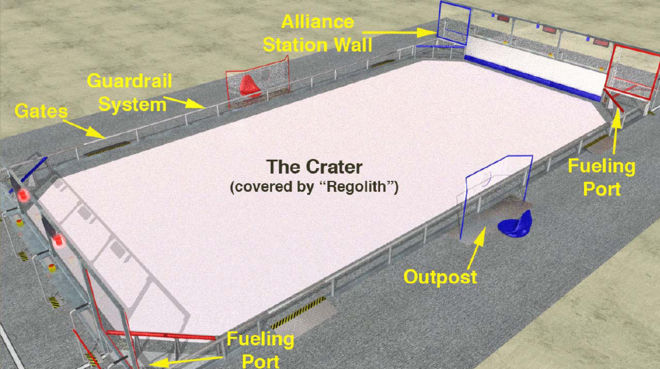
The Field for Lunacy
2008 - FIRST® Overdrive
Robots are designed to race around a track with 40" inflated Trackballs, passing them either over or under a 6' 6" overpass. Extra points are scored by robots positioning the Trackballs on the overpass before the end of the 2 minute and 15 second match. There is also a 15-second Hybrid Mode in which autonomous programmed routines can be commanded by a human player.
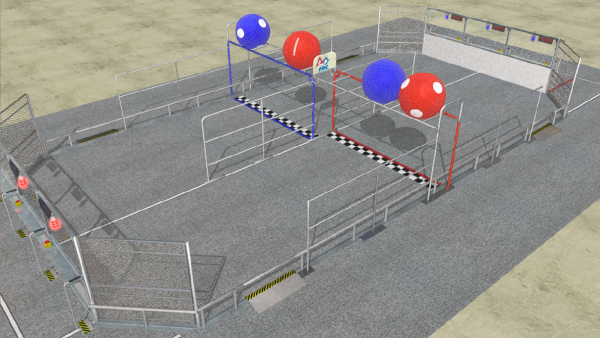
The Field for FIRST Overdrive
2007 - Rack N' Roll
Two alliances consisting of three robots each compete by hanging inflated tubes on pegs configured in round rows and columns on a 10-foot high center “rack” structure. Points are scored when rows and columns of the same color tubes are hung. A row or column of n tubes is worth 2n points to a maximum of n=8.
The first 15-seconds of the match is the Autonomous Period in which robots can place Keeper tubes on the rack. Once the Autonomous Period is complete, any Keeper tubes not already on the rack are no longer valid for scoring.
The 2-minute Teleoperated Period is when human drivers control the robot to continue to hang tubes and score points for their alliance.
The final 15 seconds of the game, the End Game, alliances can score bonus points by lifting each other's robots. If they lift the robots more than 4" off the floor, they will score 15 bonus points. If they lift the robots higher than 12" off the floor, they will score 30 bonus points.

2006 - Aim High
Two alliances, red and blue, each consisting of three robots compete against each other. During a 10-second Autonomous Mode, robots are programmed to score into any of the three goals, one raised center goal marked by a green vision target and tow corner goals at the floor level. At the end of the Autonomous Period, the alliance with the most points will gain a 10-point bonus.
During the Teleoperated Period, human drivers control their robots to score as many balls as they can during the 2-minute period.
At the end of the match, alliances can receive bonus points by placing its three robots on a platform below the center goal.
Scoring is as follows: 3 points for any ball scored in the center goal, 1 point for any ball scored in the corner goals, 10 bonus points for scoring the highest in Autonomous Mode, and 25 points for placing all 3 robots on the platform at the end (10 points for 2 robots and 5 points for 1 robot on the platform).
The Field for Aim High
2005 - Triple Play
Two alliances consisting of 3 robots each played on a 27' wide by 52' long playing field with the 9 goals configured in 3 x 3 matrix, similar to tic-tac-toe. The robots will attempt to place the red and blue game tetras in or on one or more of the nine goals to score points and “claim ownership” of the goals.
Tetras scored on the top of a goal are worth 3 points. Tetras contained insides the goals are worth 1 point. A goal was "owned" by the alliance whose color tetra was highest on or inside the goal. Rows of three owned goals garnered the alliance an additional 10 points per at the end of the match. Ten points could also be scored in all three robots in the same alliance were behind the alliance line at the end of the match.
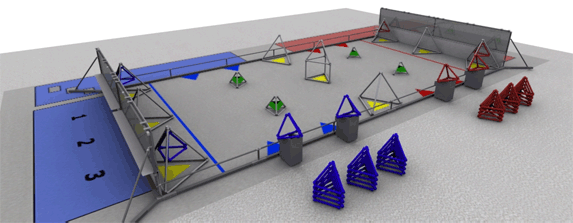
The Field for Triple Play



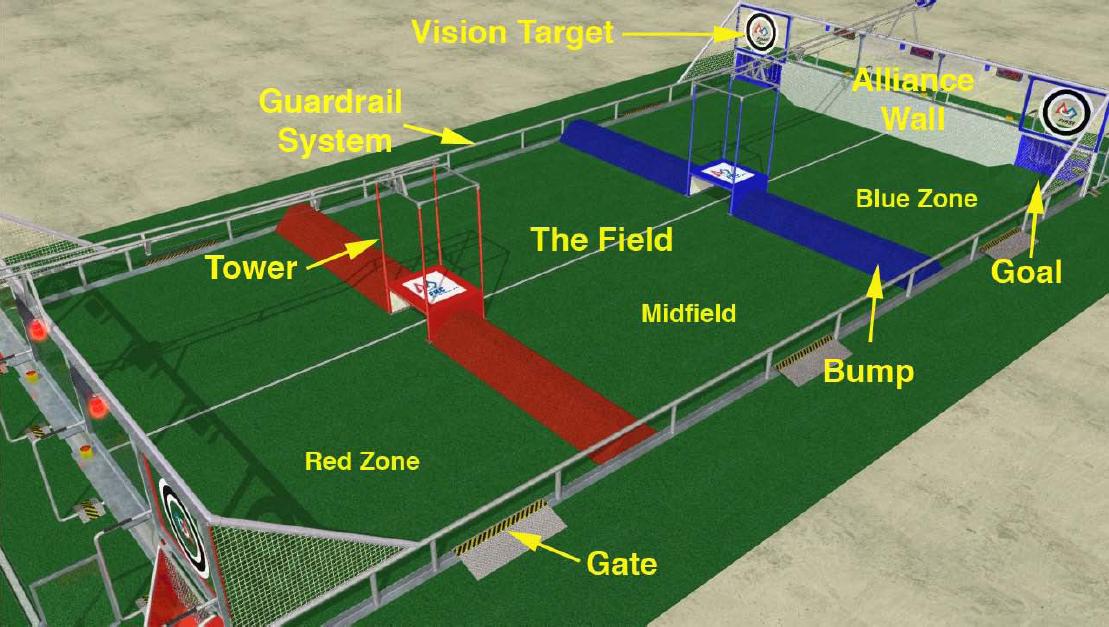

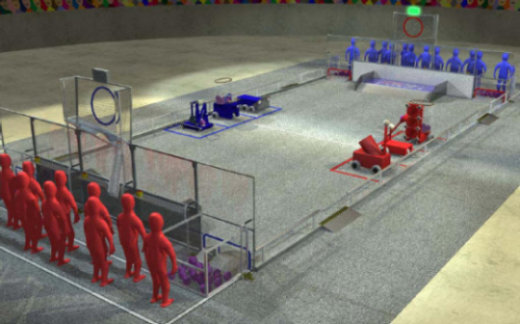






![Photos [Photos]](/images/Photos.png)


![Penfield Central School District [Penfield Central School District]](/images/penfield_side_logo.png)
![Rah Cha Cha Ruckus [Rah Cha Cha Ruckus]](/images/ruckus_side_logo.png)